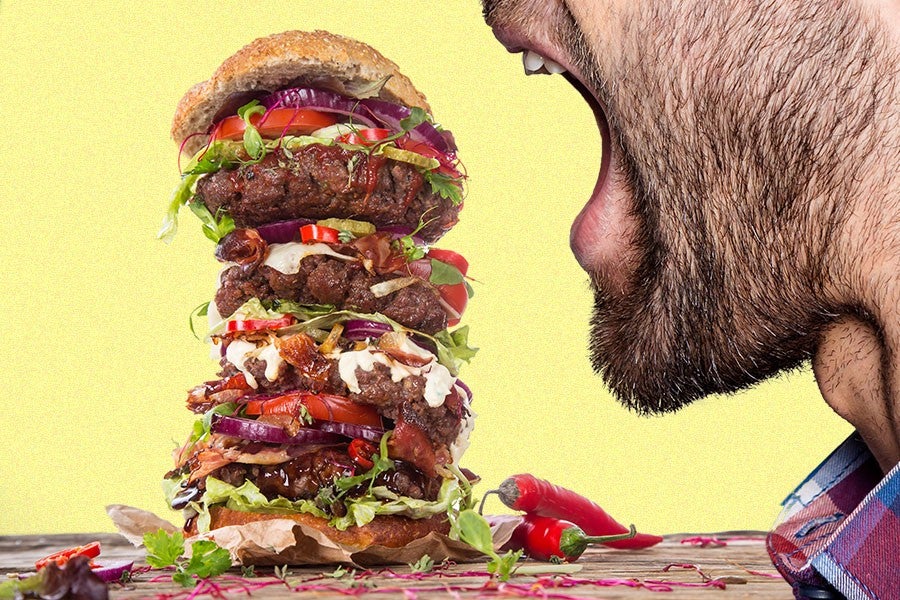There’s food, and then there’s dude food: The unholy, can-you-believe-I’m gonna-eat-this-shit Frankenstein-ing of tailgate fare and stoner snacks, glued together with Jack Daniels and bacon. It’s meat, fat, salt and hot sauce, deep fried and served with a fist bump. It’s the heart and soul of Man v. Food, Diners, Drive-ins and Dives and Epic Meal Time. And most importantly, it’s best enjoyed in front of a big-screen TV after shotgunning a few beers in the backyard.
But… why the fuck are men eating this stuff?
It goes without saying—indeed, its gross and sorta dangerous nature is kind of the whole point—but dude food involves thousands of calories and giant portions of artery-clogging fat. American men are far more likely to be overweight or obese than women (last year, 70.7 percent of adult men were overweight or obese, compared to 58.8 percent of adult women), and dude food takes this problem to its “Challenge me, brah!” extreme.
Even when not served in comical, ratings-friendly portions, the kind of foods marketed at men by popular restaurant chains are basically the same thing (Double Down, anyone?) So what is it about defiantly unhealthy food that makes it, by default, something that men are supposed to enjoy? Nina Savelle-Rocklin, a psychoanalyst who specializes in weight, food and body image issues and author of Food For Thought: Perspectives On Eating Disorders, has a few theories.
“It’s stereotypical (but also typical) that women order salads at restaurants and often take pride in denying their appetites, as if eating sparingly somehow makes them more appealing,” Savelle-Rocklin explains. “Dude food is the opposite of the, ‘Oh, I’ll only have a salad’ refrain so common in women, and is therefore a very masculine stance to take—perhaps it’s a dude’s way of unconsciously differentiating from women.”
Savelle-Rocklin also theorizes that this drive to indulge in ludicrous eats stems from the fact that men are generally more competitive than women. “There’s something about eating recklessly that’s reminiscent of extreme sports—you’re pushing your limits, which can provide an adrenaline rush,” she says. “Eating dude food is a lot like sport eating, and it’s in our DNA that guys are typically more into sports than women.”
For some men, stuffing their faces with quadruple-stacked nachos might also be a reaction to constantly repressing their feelings, since society tends to teach men to just “get over it” from a young age. “Sometimes, eating these foods can cause physical pain, which may be an unconscious way of converting emotional pain to physical pain,” Savelle-Rocklin speculates—a sort of digestive self-harm, in other words. “Many of my male patients have talked about the pressure to deny feelings, but those emotions have to come out somehow. If you can’t feel hurt because you didn’t get that raise, maybe you’re going to eat dude food to the point of physical pain, turning your hurt about the job into a stomachache.”
But Savelle-Rocklin also equates dude food to freedom, which is something pretty much everyone craves. “Think about why you’re choosing to eat a doughnut-burger mashup,” she says. “Is it because that’s a taste combination you absolutely must have, or is it a way of pushing limits and allowing yourself to have whatever the heck you want, because life is filled with constraints? Eating without limits can be the only way some guys can have what they want, when they want it.”
If Savelle-Rocklin is correct in her assumptions, then changing the way men eat requires a tidal shift in the way we view not just diet but masculinity itself. But on a personal level, if you’re a dude food fanatic who wants to eat healthier, she has this tidbit of advice: “Dude, just think about the way you’re going to feel after you eat that doughnut-burger-fries mashup,” she implores. “If the prospect of a food hangover doesn’t appeal to you, you’re on your way to making healthier choices.”
That doesn’t mean you can’t occasionally splurge on a slice of lasagna made from 45 hamburgers and a liter of Big Mac Sauce. But do it because that’s actually what you feel like eating—not because you’re eating your feelings.

